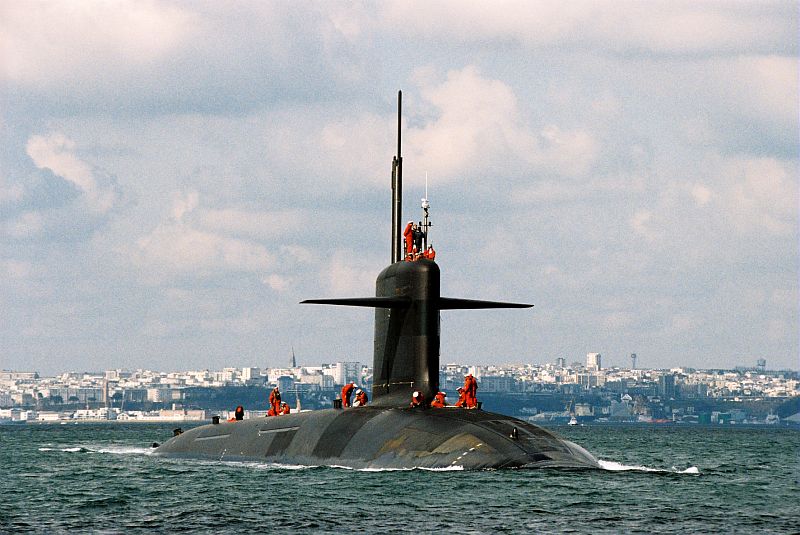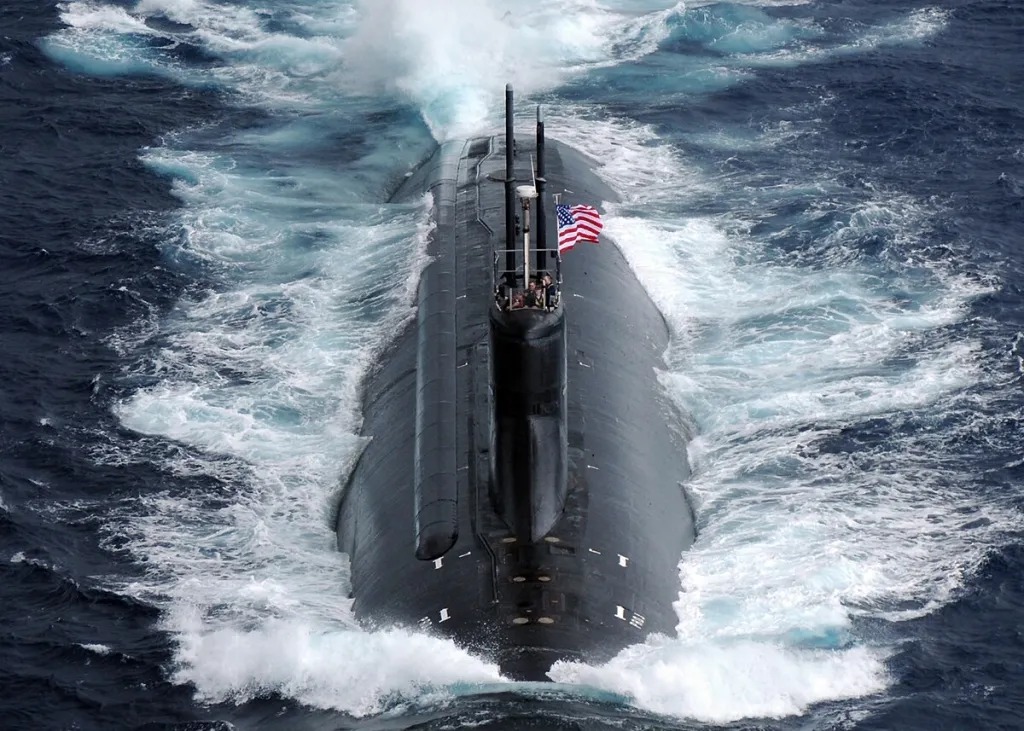Nuclear-armed stealth submarines are considered a nation’s ultimate guarantor of assured second-strike capability, as they can remain hidden and respond with vengeance. However, their aptitude to stay hidden and undetected, the so-called stealth capability, is also a potential looming danger that can cause an environmental apocalypse anytime.
In what can be described as a frightening and nightmarish scenario, one such incident happened in 2009 when two nuclear-armed NATO submarines—the UK’s HMS Vanguard and French Le Triomphant—collided deep under the Atlantic Ocean.
Both vessels were symbols of their country’s nuclear deterrence at the time. The two submarines were using passive sonar to ensure silence and avoid detection.
With a crew of 135 people, HMS Vanguard was on a routine patrol in the Eastern Atlantic Ocean, whereas Le Triomphant, with a crew of 111, was reportedly returning home from a tour of duty.
On the night of February 3, the crew of Le Triomphant felt a shock. Submerged in the East Atlantic’s strong seas, the 138-meter-long submarine—the lead of four and a vital component of France’s nuclear strike force today—was making her way back to port. This was when something struck its bow and sailed with great force. The two nuclear submarines had crashed into each other on the intervening night of February 3-4, 2009.
The French Ministry of Defense stated on February 6, 2009, that Le Triomphant “collided with an immersed object (probably a container).” However, the British government maintained studied silence and took its time to assess what had transpired on the fateful day as it was not common for submarines to collide with one another. The accident was finally confirmed by both sides on February 16.

At the time, the UK Ministry of Defense (MoD) stated that both the submarines were submerged and moving “at very low speed” at the time of the collision.
The statement also noted that while both submarines had sustained damage, no radioactive material leaked from either ship. A British official also noted that the Vanguard’s “deterrent capability remained unaffected, and there was no compromise to nuclear safety.”
As the incident started to blow over and generated widespread public interest, some reports said it was a huge cover-up, and the extent of damage was likely greater than what the two sides acknowledged. A whistleblower claimed that the British government had chosen to downplay the incident to allay public fears.
The said whistleblower reportedly served in the UK’s nuclear submarine program. He later stated: “The French submarine had taken a massive chunk out of the front of HMS Vanguard and grazed down the side of the boat. The high-pressure air (HPA) bottle groups were hanging off and banging against the pressure hull. They had to return to base port slowly because if one of the HPA bottle groups exploded, it would’ve created a chain reaction and sent the submarine plummeting to the bottom.”

These claims could not be independently verified and the reports surrounding the accident died down soon after.
Writing for EurAsian Times, Rear Admiral Sanjay Roye (R) of Indian Navy aid: “The submarines’ commitment to silence meant they could not effectively detect each other. The lack of active sonar use, a crucial tool for identifying nearby objects, significantly reduced their ability to perceive their surroundings.”
The incident made headlines because of the dangers associated with a collision between two submarines carrying nuclear weapons. France’s Le Triomphant submarine could carry sixteen M45 ballistic missiles, whereas the HMS Vanguard could carry sixteen Trident II D5 ballistic missiles. Furthermore, each submarine could carry four to six nuclear weapons.
Moreover, if the collision had been severe enough, the reactors’ containment might have been broken, exposing the crew and the surrounding oceanic waters to radiation and leading to a full-blown environmental catastrophe.
Submarines Are Stellar But Not Invincible
The collision between HMS Vanguard and Le Triomphant was not the first accident involving submarines, and it was not the last. Over the years, several submarines have collided with underwater objects—with some having run aground after the disaster.
Last year, for instance, multiple media reports alleged that a Chinese Type-093 nuclear-powered submarine had suffered an accident as it struck a “chain and anchor” trap meant to entice Western vessels hovering around the Chinese coast.
There were claims that the crew had been killed as a result of a “catastrophic failure” of the oxygen system and that the submarine had sunk. However, these reports were refuted by China, which is known to keep its military accidents under wraps.
Another major submarine accident in recent memory involves the US Navy’s Seawolf-class submarine. On October 2, 2021, the USS Connecticut (SSN-22) collided with an underwater seamount in the South China Sea.
The US investigation later revealed that the accident had occurred due to the crew’s lapses in navigation planning and unfamiliarity with the South China Sea. The incident caused significant damage to its forward section, particularly the sonar dome, and severely impacted the Navy’s operations.
Nuclear submarines are possibly the most classified and strategically important military assets a country has. Their stealth is essential for preventing attacks, obtaining intelligence, and preserving operational supremacy. However, they have limitations, as seen in the above-stated collision.
Submarines primarily use sonar to find underwater objects, other ships, and any dangers. Sonar comes in two varieties: active and passive.

Active sonar provides comprehensive environmental data by emitting sound waves that reflect off objects and back to the submarine. However, submarines would not actively ping until absolutely necessary since active sonar weakens a submarine’s stealth by disclosing its location to others.
So, submarines mostly use passive sonar—which listens for environmental sounds without sending out detectable signals—to stay stealthy. However, passive sonar is not without its limitations. It is unable to detect objects that don’t emit noise, such as underwater mountains, drifting or halted ships, or other submarines working nearby.
“This was a contributing factor in the collision between HMS Vanguard and Le Triomphant, as both submarines were operating silently and did not detect each other,” said Rear Admiral Roye.
He further added, “Submarines are designed to operate undetected, which is essential for their missions. However, this emphasis on stealth often results in reduced use of active sonar and radio communications. The less a submarine emits, the harder it is to detect—but this also makes it more vulnerable to collisions with other submarines or vessels. The 2009 collision between HMS Vanguard and Le Triomphant was a direct result of both submarines operating in stealth mode, with their onboard machinery and sonar systems minimized to avoid detection.”
Despite all their vulnerabilities, submarines are still the most reliable form of deterrence and attack capability. They have a tactical advantage that few other military platforms can match because they can obtain intelligence in dangerous areas while staying hidden.
They also provide countries with an assured second-strike capability. While a country’s ground and air-based nuclear forces can be knocked down with a preemptive strike, submarines hidden deep inside seawater will be nearly impossible to track and destroy.
And herein lies a lacuna: While not using active sonar makes submarines susceptible to such collisions, using active sonar will make them vulnerable to detection and thus defeat their whole purpose of existence.
Theoretically, countries can share information about their submarine patrols to avoid underwater collisions. However, in reality, even friendly countries will not share such information, as is amply clear from the example of HMS Vanguard and Le Triomphant—as both the UK and France are friendly countries and part of NATO. Thus, submarines will, perhaps, forever be susceptible to underwater collisions.
- Contact the author at sakshi.tiwari9555 (at) gmail.com
- Follow EurAsian Times on Google News




